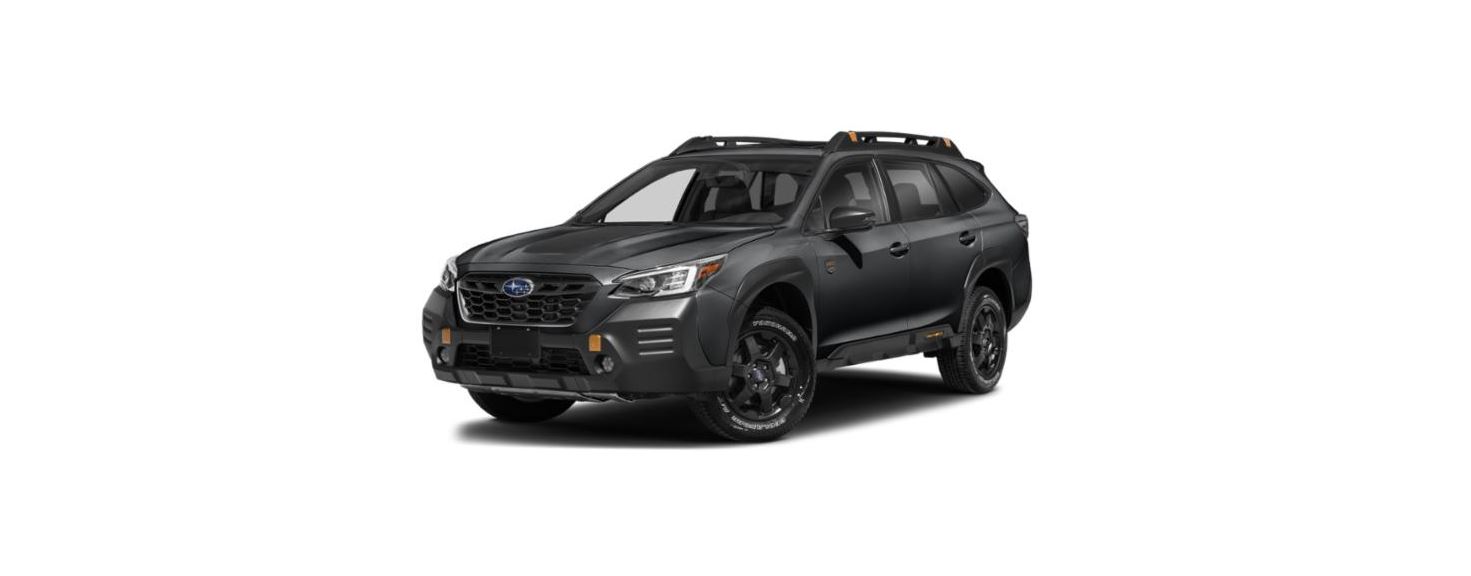2022 Subaru Outback Reverse Automatic Braking (RAB) System (If Equipped)
 Reverse Automatic Braking (RAB) System (If Equipped)
Reverse Automatic Braking (RAB) System (If Equipped)
Reverse Automatic Braking (RAB) is a system designed to help avoid collisions or reduce collision damage when reversing the vehicle. If a wall or an obstacle is detected in the reversing direction, the system will notify the driver with a warning sound and may activate the vehicle’s brakes automatically.
WARNING
- Reverse Automatic Braking (RAB) is not a system intended to replace the driver’s responsibility to check their surroundings for vehicles or obstacles to avoid a collision.
- The driver is responsible for driving safely. Before reversing, be sure to first depress the brake pedal and visually check the surroundings.
- There are some cases in which the vehicle cannot avoid a collision, because the system operation has limitations. The warning sound or automatic braking may be delayed or may not operate at all even when an obstacle is present.
- Make sure to set the Automatic Braking to OFF when the vehicle is on the free roller or on the chassis dynamometer. Otherwise, the vehicle may move and it may cause an accident.
- Make sure to set the Automatic Braking to OFF when towing a trailer. Otherwise, the vehicle may move and it may cause an accident.
- The system is not designed to detect people (including children), animals or other moving objects.
- Depending on the vehicle condition or the surrounding environment, the sonar sensor’s ability to detect objects may become unstable `
NOTE
The Reverse Automatic Braking (RAB) system records and stores the following data when automatic braking operates. It does not record conversations, personal information or other audio data.
- Distance from the object
- Vehicle speed
- Accelerator pedal operation status. Brake pedal operation status
- Select lever position
- Outside temperature
- The sensitivity setting of the sonar sensors
SUBARU and third parties contracted by SUBARU may acquire and use the recorded data for the purpose of vehicle research and development. SUBARU and third parties contracted by SUBARU will not disclose or provide the acquired data to any other third party except under the following conditions. - The vehicle owner has given his/her consent.
- The disclosure/provision is based on a court order or other legally enforceable request.
- Data that has been modified so that the user and vehicle cannot be identified is provided to a research institution for statistical processing or similar purposes.
Reverse Automatic Braking (RAB) System Overview
The Reverse Automatic Braking (RAB) system will operate the following 2 functions using 4 sonar sensors.
Sonar Audible Alarm
The Reverse Automatic Braking (RAB) system detects objects rearward and warns the driver by a warning message on the central information display and warning beeps.
Automatic Braking
The automatic braking detects objects rearward and if there is a high risk of a collision, the system decelerates the vehicle and controls the braking to reduce damage.
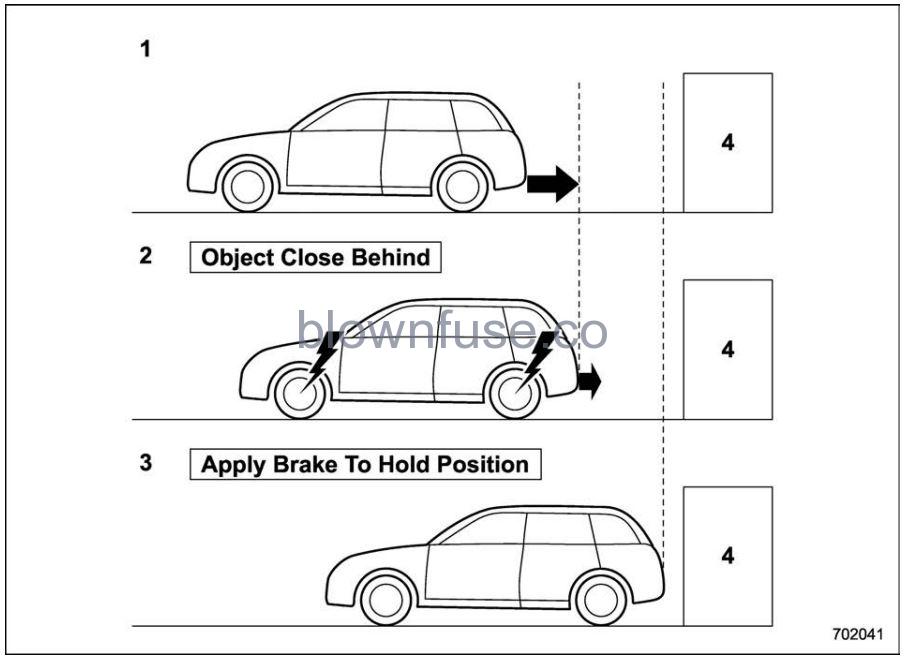
WARNING
If your vehicle is trapped on a railroad crossing and you are trying to escape by reversing through the crossing gate, the system may recognize the crossing gate as an obstacle and the brake may activate. In this case, remain calm and either continue to depress the accelerator pedal or cancel the system. To cancel the system, refer to “Cancel-ing the Reverse Automatic Braking (RAB) System Operation” P406.
- When reversing
- When either strong automatic braking or torque control is applied to prevent collision (in this case, short warning beeps or continuous warning beeps will sound)
- When the vehicle is stopped by the system (in this case, the continuous beep will remain sounding)
- Object (e.g., a wall)
Operating Conditions
The Reverse Automatic Braking (RAB) system will operate when all of the following conditions are met.
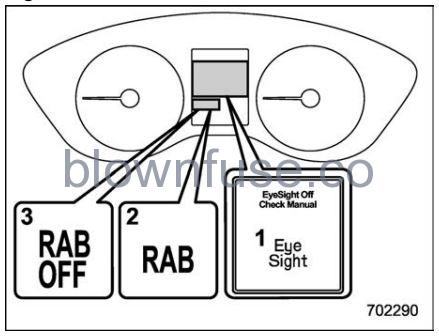
- EyeSight warning indicator
- RAB warning indicator
- RAB OFF indicator
- The ignition switch is in the “ON” position.
- The EyeSight warning indicator is off. . The RAB warning indicator is off.
- The RAB OFF indicator is off.
- The select lever is in the “R” position.
Sonar Audible Alarm
- The sonar audible alarm is set to “ON”. . The vehicle speed is from 0 to 9 mph (0 to 15 km/h).
Automatic Braking
- The automatic braking is set to “ON”. . The vehicle speed is from 1 to 9 mph (1.5 to 15 km/h).
NOTE
- In the following cases, the Reverse Automatic Braking (RAB) system will not operate. Promptly contact a SUBARU dealer to have the system inspected.
- The EyeSight warning indicator is illuminated.
- The RAB warning indicator is illuminated.
- In the following cases, the Reverse Automatic Braking (RAB) system can not be operated.
- The (EyeSight Temporary Stop indicator: White) is illuminated, and the messages corresponding to the EyeSight temporary stop are displayed on the combination meter display (color LCD). For details, refer to the Owner’s Manual Supplement for the EyeSight system.
- The RAB OFF indicator is illuminated.
- In the following cases, the functions may not be able to properly work. Promptly contact a SUBARU dealer to have the system inspected.
- A sticker, paint, or a chemical is applied to the sonar sensors or the rear bumper near the sonar sensor.
- The rear bumper is modified.
- The rear bumper has been removed and attached.
- The ground clearance is changed due to the vehicle’s loading condition or modification.
- There is damage to the sonar sensors or the rear bumper near the sonar sensor.
- The rear bumper is exposed to strong impact, or the rear bumper is deformed.
- On a steep hill, the system’s automatic braking ability will be reduced. . The system is designed to avoid collisions by automatic hard braking when the vehicle’s reversing speed is less than approximately 3 mph (5 km/h). However, the system does not guarantee that the vehicle will be able to avoid collisions in any situation.
- If the vehicle is reversed at an extremely slow speed, the driver’s operation may be prioritized. In this case, automatic braking will not operate.
- The system may not be able to detect and apply the brake with the following objects.
- Sharp or thin objects such as poles, fences, and ropes may not reflect the sound wave emitted from the sonar sensor.
- Objects that are too close to the rear bumper when the select lever is set to the “R” position.
- Objects with a surface that may not reflect the sound wave emitted from the sonar sensor such as a chain-link fence.
- Objects the system is not designed to detect and apply the brake.
- Pedestrians.
- Moving objects including moving vehicles.
- Objects which absorb sound waves such as cloth or snow.
- Objects whose surface has a diagonal angle.
- Objects that are low to the ground such as parking blocks.
- Objects that are high above the ground such as objects hanging from above.
- Objects that are out of range of the center of the vehicle in the horizontal direction.
- Objects that are not in a vertical direction.
- When reversing the vehicle, the functions may not be able to work properly or may cause a system malfunction if the following conditions exist.
- High-frequency sounds from other sources are nearby:
- Horn sound from another vehicle.
- Engine sound from other vehicles.
- Sound of an air brake.
- Vehicle detection equipment or a sonar from another vehicle.
- A sound wave with a frequency similar to the vehicle’s system is transmitted nearby.
- A vehicle equipped with the same system is reversing toward your reversing direction.
Weather conditions
- Extremely high or extremely low temperatures in which the area near the sonar sensor becomes too hot or too cold to operate.
- The sonar sensors or the rear bumper near the sonar sensors are exposed to heavy rain or a significant amount of water.
- Fog, snow or sandstorm, etc.
- Air is moving rapidly such as when a strong wind is blowing.
- Parts attached to the rear bumper near the sonar sensor:
- Commercial electronic parts (fog light, fender pole, radio antenna) or commercial attachment parts (trailer hitch, bicycle carrier, bumper guard) are attached.
- Parts that emit high-frequency sounds, such as a horn or speaker, are attached.
Vehicle conditions
- Ice, snow or mud adheres to the sonar sensors or the rear bumper near the sonar sensor.
- The vehicle is significantly inclined.
- The ground clearance is significantly reduced due to the vehicle’s loading condition, etc.
- When the sonar sensor is misaligned due to a collision or an accident.
Surrounding environment
- A cloth banner, flag, hanging branch or railroad crossing bars are present in the reversing direction.
- When reversing on gravel or grassy area.
- When reversing in an area where objects or walls are adjacent to the vehicle such as narrow tunnels, narrow bridges, narrow roads or narrow garages.
- Wheel track or hole is present in the ground of the reversing direction.
- When reversing over a drainage cover (grating cover).
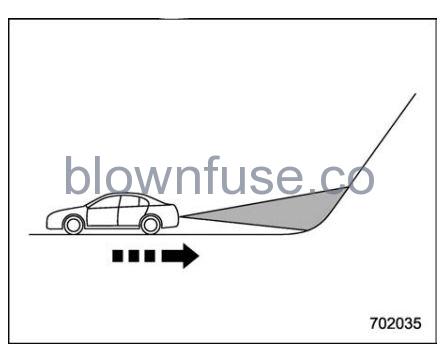
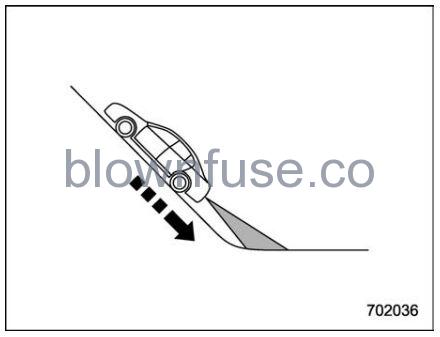
- The path of the reversing direction is inclined such as on a steep uphill.
- When reversing downhill.
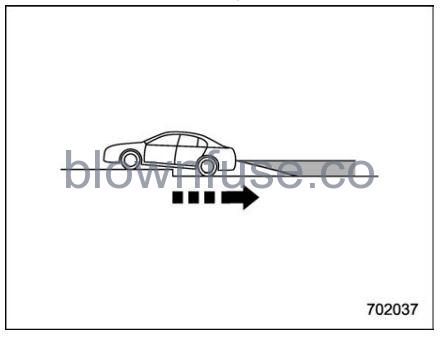
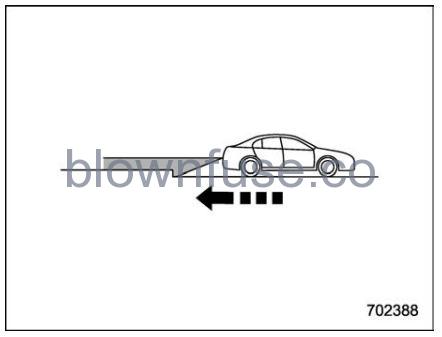
- A curb or step is present in the reversing direction.
- Reversing in a garage with a low ceiling or a tunnel.
- There is a patch of snow rear-ward.
- There is a puddle of water.
- There is an obstacle that is next to an object.
- Going back along a wall.
- The area where the road starts touching dirt and snow
- When reversing on an uneven road.
In circumstances such as the following, it may not be possible to avoid a collision even when the system operates normally.
- Roads are slippery.
- The tire air pressure is not correct.
- The tires have become worn.
- Tire chains are installed.
- Tires that are not the designated size are installed.
- Emergency repairs were performed using a puncture repair kit.
- The suspension was modified.
- Vehicle driving is unstable due to accidents or malfunction.
- The brake warning light is illuminated.
Sonar Audible Alarm
When Reverse Automatic Braking (RAB) system is in operation, an audible warning beeps will sound in 3 levels to warn the driver of a potential collision.
NOTE
It may take time to display the wall and sound warning beeps after the object was recognized by the sonar audible alarm.
Guideline of detecting range
| Alert level | Range of detected object* | Distance indicator | Alarm pattern |
| Long proximity (ob- ject detected) | 28 in (70 cm) or more | Green | No warning sound |
| Medium proximity alert (approaching the object) |
20 to 28 in (50 to 70 cm) |
Yellow |
Short beeps |
| Short proximity alert (approaching closer to the object) |
12 to 20 in (30 to 50 cm) |
Orange |
Rapid short beeps |
| Closest proximity alert (too close to the object) |
12 in (30 cm) or less |
Red |
Continuous beep |
The range of detection may vary depending on the environmental condition.
Obstacle detected and alert level
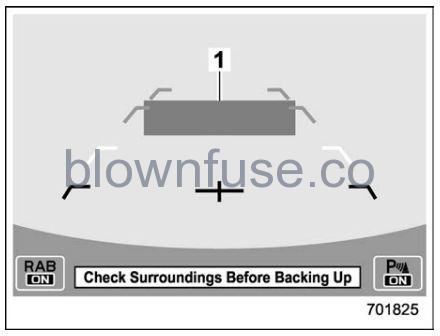
Long proximity alert (object detected)
- Green: 28 in (70 cm) or more
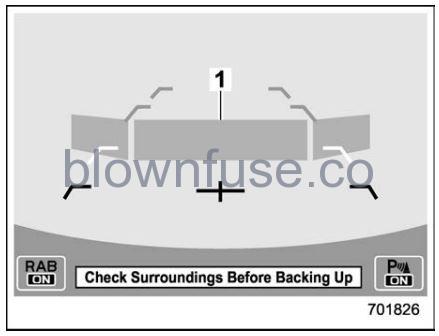
Medium proximity alert (approaching the object)
- Yellow: 20 to 28 in (50 to 70 cm)
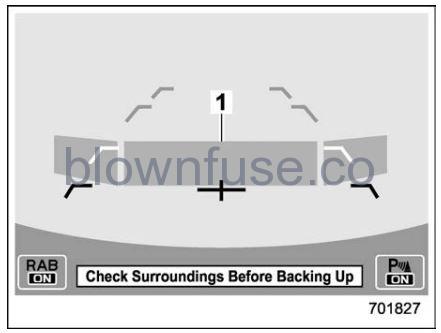
Short proximity alert (approaching the object closer)
- Orange: 12 to 20 in (30 to 50 cm)
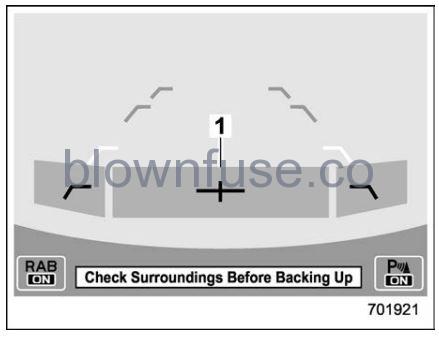
Closest proximity alert (too close to the object)
- Red: 12 in (30 cm) or less
When an object is detected in the rever-sing direction, the range of the detected object will be shown on the central information display. A warning alarm will sound and, depending on the speed, either torque control to generate engine braking or automatic braking will be applied.
Automatic Braking Operation
Object close behind the warning
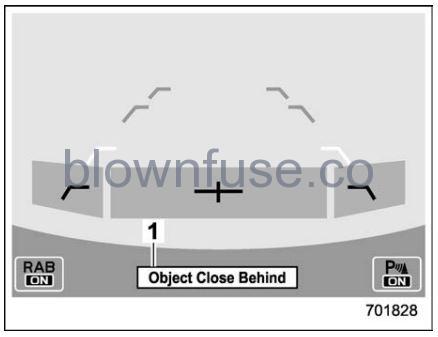
Automatic braking warning
- Warning message
If the system determines the risk of collision with the object. Short warning beeps or continuous warning beeps will sound and either strong automatic braking or torque control will be applied to prevent a collision. At this time, a warning message is also displayed on the combination meter dis-play (color LCD).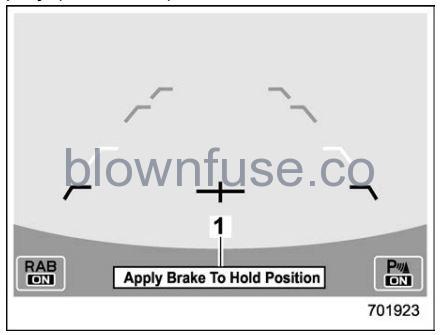
Depress brake pedal warning
- Warning message
Make sure to depress the brake pedal once the vehicle has been stopped by automatic braking. Until the brake pedal is depressed, a message will be displayed on the central information display and the continuous beep will remain sounding. At this time, a warning message is also displayed on the combination meter dis-play (color LCD).
NOTE
The sonar audible alarm and automatic braking are different in operation conditions. Therefore there are cases in which only one of these functions will activate.
WARNING
Depress the brake pedal immediately after the system stops the vehicle by automatic braking. Depending on the conditions of the road surface and tires, the vehicle may not remain stopped, possibly leading to an accident.
After the vehicle is stopped by the system
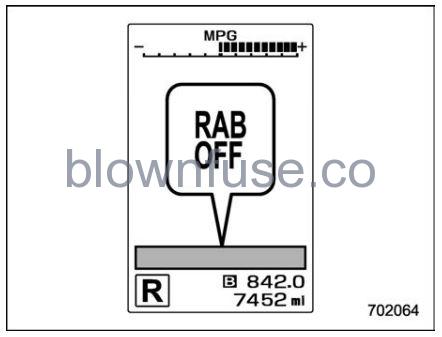
After the brake pedal is depressed, the RAB OFF indicator will illuminate and the system will temporarily stop operating. The RAB OFF indicator will turn off when the select lever is shifted to a position other than the “R” position. The system will operate again the next time the select lever is shifted to the “R” position. In circumstances such as the following, the Reverse Automatic Braking (RAB) system automatically stops operating and the RAB OFF indicator illuminates.
- There is ice, snow, mud, or other substance on the sonar sensors.
- The select lever was shifted to “R”
- when there was an obstacle located close to the rear bumper.
- A sound with a frequency close to that of the sonar used by the Reverse Automatic Braking (RAB) system was detected.
NOTE
- In the following cases, after the vehicle has been stopped by the Re-verse Automatic Braking (RAB) system, brake control is released and the electronic parking brake operates. For details about releasing the parking brake, refer to “Electronic Parking Brake” P370.
- When 2 minutes pass after the vehicle is stopped
- When any door is opened
- The Reverse Automatic Braking (RAB) system may stop operating temporarily in the following cases and the RAB OFF indicator will illuminate.
- Ice, snow or mud adheres to the sonar sensors or the rear bumper near the sonar sensor
- Objects are too close to the rear bumper when the select lever is set to the “R” position
- The system detects sounds of a similar frequency to the RAB sonar
Canceling the Reverse Automatic Braking (RAB) System Operation
- The Reverse Automatic Braking (RAB) system can be temporarily canceled by any of the following operations.
- While the vehicle is stopped by the operation of automatic braking, the brake pedal is depressed.
- While the vehicle is stopped by the operation of automatic braking, the accelerator pedal is depressed.
- The accelerator pedal is depressed continuously (In this case, limited acceleration will be canceled and the vehicle will continue reversing.)
- The select lever is shifted to a position other than the “R” position.
NOTE
The system will be canceled if the object is no longer detected.
Reverse Automatic Braking (RAB) System ON/OFF Setting
While the select lever is shifted to the “R” position, the below functions of the Re-verse Automatic Braking (RAB) system can be set by operating the center in- formation display.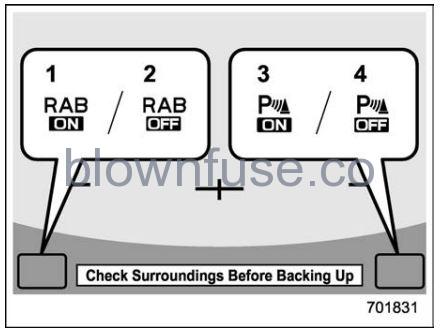
- ON setting the key of automatic braking
- OFF setting key of automatic braking
- ON setting the key of the sonar audible alarm
- OFF setting the key of the sonar audible alarm
When the ON setting key is shown, the corresponding setting is ON. Touch and hold the ON setting key to turn the setting OFF. When the OFF setting is shown, the corresponding setting is OFF. Touch and hold the OFF setting key to turn the setting ON. When the automatic braking are turned OFF, the following indicator(s) will illuminate.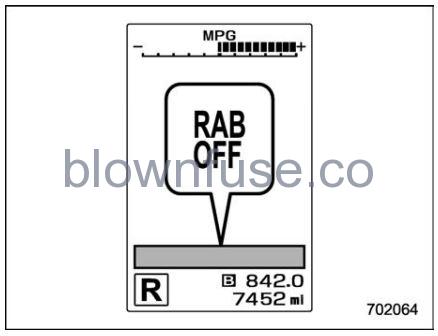
The RAB OFF indicator will turn off when the corresponding function is turned ON.
NOTE
When the settings cannot be changed, the ON/OFF setting key will be grayed out. Also, the following settings can be changed by operating the center information display.
- Warning Volume
- Sonar Audible Alarm
For details, refer to “Car settings” P223.
RAB Warning Indicator

- RAB malfunction message
- RAB warning indicator
If the Reverse Automatic Braking (RAB) system malfunctions, the above indicator illuminates on the combination meter. Contact the nearest SUBARU dealer for details.
Handling of the Sonar Sensors
The 4 sonar sensors are located in the rear bumper. To ensure the proper operation of the Reverse Automatic Braking (RAB) system, observe the following precautions.
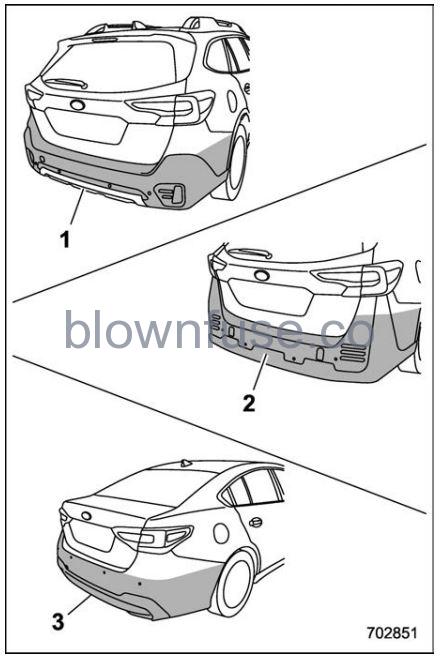
- Outback
- Subaru Outback Wilderness
- Legacy
- Do not affix any stickers or other items on the sonar sensor or the bumper surface near the sonar sensors.
- Always keep the sonar sensor and the rear bumper surface near the sonar sensors clean.
- Do not modify the rear bumper.
- Do not paint the bumper near the sonar sensors.
- Do not apply high-pressure water to the sonar sensors with a high-pressure car-washing machine.
- Do not apply strong impacts to the rear bumper near the sonar sensors. If a sensor becomes misaligned, a system malfunction may occur, including the inability to detect objects in the reversing direction. If any strong impact is applied to the rear bumper, contact a SUBARU dealer to have the system inspected.
- Do not disassemble the sonar sensors.
NOTE
If the sonar sensors require repair or replacement, or if the area of the rear bumper near the sonar sensors requires repair, paintwork, or replacement, contact your SUBARU dealer for assistance.
